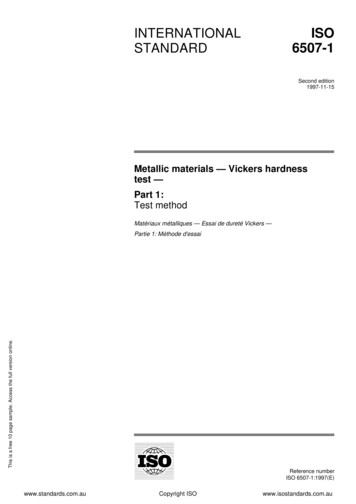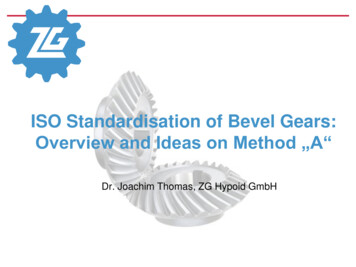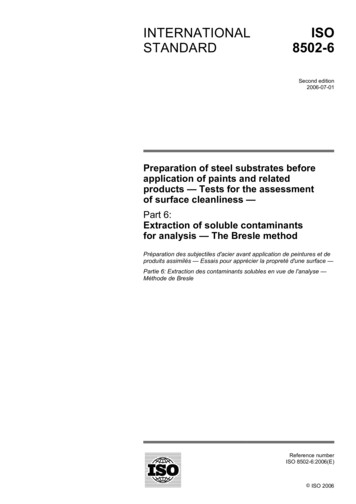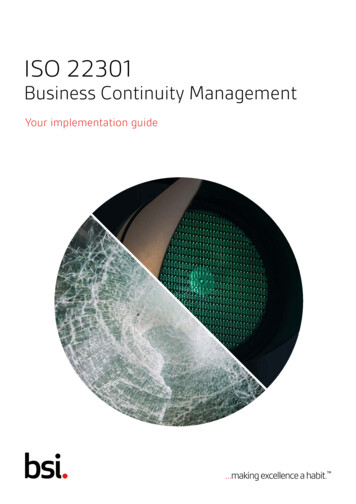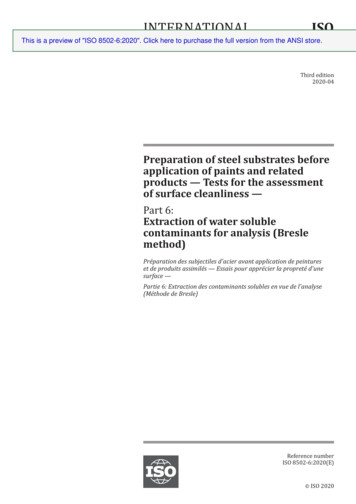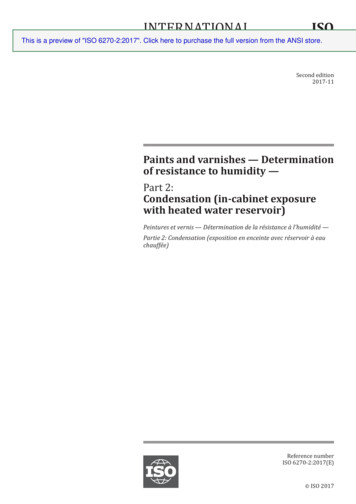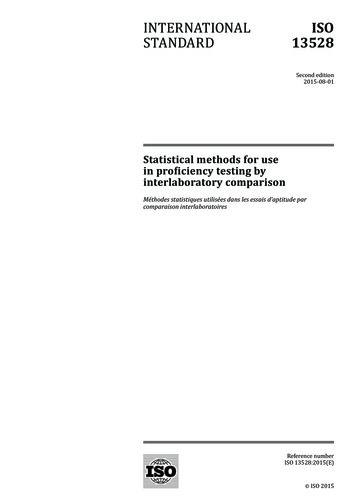
Transcription
ISO13528INTERNATIONALSTANDARDSecond edition2015-08-01Statistical methods for usein proficiency testing byinterlaboratory comparisonMéthodes statistiques utilisées dans les essais d’aptitude parcomparaison interlaboratoiresReference numberISO 13528:2015(E) ISO 2015
ISO 13528:2015(E) COPYRIGHT PROTECTED DOCUMENT ISO 2015, Published in SwitzerlandAll rights reserved. Unless otherwise specified, no part of this publication may be reproduced or utilized otherwise in any formor by any means, electronic or mechanical, including photocopying, or posting on the internet or an intranet, without priorwritten permission. Permission can be requested from either ISO at the address below or ISO’s member body in the country ofthe requester.ISO copyright officeCh. de Blandonnet 8 CP 401CH-1214 Vernier, Geneva, SwitzerlandTel. 41 22 749 01 11Fax 41 22 749 09 47copyright@iso.orgwww.iso.orgii ISO 2015 – All rights reserved
ISO 13528:2015(E) Contents PageForeword.v0123456789Introduction. viScope. 1Normative references. 1Terms and definitions. 1General principles. 44.1General requirements for statistical methods. 4Basic model. 54.24.3General approaches for the evaluation of performance. 5Guidelines for the statistical design of proficiency testing schemes. 6Introduction to the statistical design of proficiency testing schemes. 65.15.2Basis of a statistical design. 65.3Considerations for the statistical distribution of results. 75.4Considerations for small numbers of participants. 8Guidelines for choosing the reporting format. 85.5Guidelines for the initial review of proficiency testing items and results.106.1Homogeneity and stability of proficiency test items. 10Considerations for different measurement methods. 116.26.3Blunder removal. 11Visual review of data. 116.46.5Robust statistical methods. 126.6Outlier techniques for individual results. 12Determination of the assigned value and its standard uncertainty.13Choice of method of determining the assigned value. 137.17.2Determining the uncertainty of the assigned value. 147.3Formulation. 15Certified reference material. 157.47.5Results from one laboratory . 16Consensus value from expert laboratories. 177.67.7Consensus value from participant results . 187.8Comparison of the assigned value with an independent reference value. 19Determination of criteria for evaluation of performance .208.1Approaches for determining evaluation criteria. 208.2By perception of experts. 208.3By experience from previous rounds of a proficiency testing scheme. 208.4By use of a general model. 218.5Using the repeatability and reproducibility standard deviations from a previouscollaborative study of precision of a measurement method. 228.6From data obtained in the same round of a proficiency testing scheme. 228.7Monitoring interlaboratory agreement. 23Calculation of performance statistics.239.1General considerations for determining performance. 239.2Limiting the uncertainty of the assigned value. 249.3Estimates of deviation (measurement error) . 259.4z scores . 269.5z′ scores. 279.6Zeta scores (ζ). 289.7En scores. 299.8Evaluation of participant uncertainties in testing. 299.9Combined performance scores. 30 ISO 2015 – All rights reserved iii
ISO 13528:2015(E) 1011Graphical methods for describing performance scores .3110.1 Application of graphical methods. 3110.2 Histograms of results or performance scores. 3110.3 Kernel density plots. 3210.4 Bar-plots of standardized performance scores. 3310.5 Youden Plot. 3310.6 Plots of repeatability standard deviations. 3410.7 Split samples . 3510.8 Graphical methods for combining performance scores over several rounds of aproficiency testing scheme . 36Design and analysis of qualitative proficiency testing schemes (including nominaland ordinal properties).3711.1 Types of qualitative data. 3711.2 Statistical design. 3711.3 Assigned values for qualitative proficiency testing schemes. 3811.4 Performance evaluation and scoring for qualitative proficiency testing schemes. 39Annex A (normative) Symbols.42Annex B (normative) Homogeneity and stability of proficiency test items.44Annex C (normative) Robust analysis.52Annex D (informative) Additional Guidance on Statistical Procedures.63Annex E (informative) Illustrative Examples.67Bibliography. 89iv ISO 2015 – All rights reserved
ISO 13528:2015(E) ForewordISO (the International Organization for Standardization) is a worldwide federation of national standardsbodies (ISO member bodies). The work of preparing International Standards is normally carried outthrough ISO technical committees. Each member body interested in a subject for which a technicalcommittee has been established has the right to be represented on that committee. Internationalorganizations, governmental and non-governmental, in liaison with ISO, also take part in the work.ISO collaborates closely with the International Electrotechnical Commission (IEC) on all matters ofelectrotechnical standardization.The procedures used to develop this document and those intended for its further maintenance aredescribed in the ISO/IEC Directives, Part 1. In particular the different approval criteria needed for thedifferent types of ISO documents should be noted. This document was drafted in accordance with theeditorial rules of the ISO/IEC Directives, Part 2 (see www.iso.org/directives).Attention is drawn to the possibility that some of the elements of this document may be the subject ofpatent rights. ISO shall not be held responsible for identifying any or all such patent rights. Details ofany patent rights identified during the development of the document will be in the Introduction and/oron the ISO list of patent declarations received (see www.iso.org/patents).Any trade name used in this document is information given for the convenience of users and does notconstitute an endorsement.For an explanation on the meaning of ISO specific terms and expressions related to conformityassessment, as well as information about ISO’s adherence to the WTO principles in the TechnicalBarriers to Trade (TBT) see the following URL: Foreword - Supplementary informationThe committee responsible for this document is ISO/TC 69, Applications of statistical methods,Subcommittee SC 6, Measurement methods and results.This second edition of ISO 13528 cancels and replaces the first edition (ISO 13528:2005), of whichit constitutes a technical revision. This second edition provides changes to bring the document intoharmony with ISO/IEC 17043:2010, which replaced ISO Guide 43-1:1997. It follows a revised structure,to describe better the process of the design, analysis, and reporting of proficiency testing schemes. Italso eliminates some procedures that are no longer considered to be appropriate, and adds or revisessome other sections to be consistent with ISO/IEC 17043 and to provide clarity and correct minorerrors. New sections have been added for qualitative data and additional robust statistical methods. ISO 2015 – All rights reserved v
ISO 13528:2015(E) 0Introduction0.1The purposes of proficiency testingProficiency testing involves the use of interlaboratory comparisons to determine the performanceof participants (which may be laboratories, inspection bodies, or individuals) for specific tests ormeasurements, and to monitor their continuing performance. There are a number of typical purposes ofproficiency testing, as described in the Introduction to ISO/IEC 17043:2010. These include the evaluationof laboratory performance, the identification of problems in laboratories, establishing effectiveness andcomparability of test or measurement methods, the provision of additional confidence to laboratorycustomers, validation of uncertainty claims, and the education of participating laboratories. Thestatistical design and analytical techniques applied must be appropriate for the stated purpose(s).0.2Rationale for scoring in proficiency testing schemesA variety of scoring strategies is available and in use for proficiency testing. Although the detailedcalculations differ, most proficiency testing schemes compare the participant’s deviation from anassigned value with a numerical criterion which is used to decide whether or not the deviationrepresents cause for concern. The strategies used for value assignment and for choosing a criterionfor assessment of the participant deviations are therefore critical. In particular, it is important toconsider whether the assigned value and criterion for assessing deviations should be independent ofparticipant results, or should be derived from the results submitted. In this Standard, both strategiesare provided for. However, attention is drawn to the discussion that will be found in sections 7 and 8 ofthe advantages and disadvantages of choosing assigned values or criteria for assessing deviations thatare not derived from the participant results. It will be seen that in general, choosing assigned values andassessment criteria independently of participant results offers advantages. This is particularly the casefor the criterion used to assess deviations from the assigned value – such as the standard deviation forproficiency assessment or an allowance for measurement error – for which a consistent choice based onsuitability for a particular end use of the measurement results, is especially useful.0.3ISO 13528 and ISO/IEC 17043ISO 13528 provides support for the implementation of ISO/IEC 17043 particularly, on the requirementsfor the statistical design, validation of proficiency test items, review of results, and reporting summarystatistics. Annex B of ISO/IEC 17043:2010 briefly describes the general statistical methods that areused in proficiency testing schemes. This International Standard is intended to be complementary toISO/IEC 17043, providing detailed guidance that is lacking in that document on particular statisticalmethods for proficiency testing.The definition of proficiency testing in ISO/IEC 17043 is repeated in ISO 13528, with the Notes thatdescribe different types of proficiency testing and the range of designs that can be used. This Standardcannot specifically cover all purposes, designs, matrices and measurands. The techniques presented inISO 13528 are intended to be broadly applicable, especially for newly established proficiency testingschemes. It is expected that statistical techniques used for a particular proficiency testing scheme willevolve as the scheme matures; and the scores, evaluation criteria, and graphical techniques will berefined to better serve the specific needs of a target group of participants, accreditation bodies, andregulatory authorities.ISO 13528 incorporates published guidance for the proficiency testing of chemical analytical laboratories[32] but additionally includes a wider range of procedures to permit use with valid measurement methodsand qualitative identifications. This revision of ISO 13528:2005 contains most of the statistical methodsand guidance from the first edition, extended as necessary by the previously referenced documents andthe extended scope of ISO/IEC 17043. ISO/IEC 17043 includes proficiency testing for individuals andinspection bodies, and Annex B, which includes considerations for qualitative results.This Standard includes statistical techniques that are consistent with other International Standards,particularly those of TC69 SC6, notably the ISO 5725 series of standards on Accuracy: trueness andprecision. The techniques are also intended to reflect other international standards, where appropriate,and are intended to be consistent with ISO/IEC Guide 98-3 (GUM) and ISO/IEC Guide 99 (VIM).vi ISO 2015 – All rights reserved
ISO 13528:2015(E) 0.4Statistical expertiseISO/IEC 17043:2010 requires that in order to be competent, a proficiency testing provider shall haveaccess to statistical expertise and shall authorize specific personnel to conduct statistical analysis.Neither ISO/IEC 17043 nor this International Standard can specify further what that necessary expertiseis. For some applications an advanced degree in statistics is useful, but usually the needs for expertisecan be met by individuals with technical expertise in other areas, who are familiar with basic statisticalconcepts and have experience or training in the common techniques applicable to the analysis of datafrom proficiency testing schemes. If an individual is charged with statistical design and/or analysis, itis very important that this person has experience with interlaboratory comparisons, even if that personhas an advanced degree in statistics. Conventional advanced statistical training often does not includeexercises with interlaboratory comparisons, and the unique causes of measurement error that occurin proficiency testing can seem obscure. The guidance in this International Standard cannot provideall the necessary expertise to consider all applications, and cannot replace the experience gained byworking with interlaboratory comparisons.0.5Computer softwareComputer software that is needed for statistical analysis of proficiency testing data can vary greatly,ranging from simple spread sheet arithmetic for small proficiency testing schemes using knownreference values to sophisticated statistical software used for statistical methods reliant on iterativecalculations or other advanced numerical methods. Most of the techniques in this InternationalStandard can be accomplished by conventional spread sheet applications, perhaps with customisedroutines for a particular scheme or analysis; some techniques will require computer applications thatare freely available (at the time of publication of this Standard). In all cases, the users should verify theaccuracy of their calculations, especially when special routines have been entered by the user. However,even when the techniques in this International Standard are appropriate and correctly implementedby adequate computer applications, they cannot be applied without attention from an individual withtechnical and statistical expertise that is sufficient to identify and investigate anomalies that can occurin any round of proficiency testing. ISO 2015 – All rights reserved vii
INTERNATIONAL STANDARD ISO 13528:2015(E)Statistical methods for use in proficiency testing byinterlaboratory comparison1 ScopeThis International Standard provides detailed descriptions of statistical methods for proficiencytesting providers to use to design proficiency testing schemes and to analyse the data obtained fromthose schemes. This Standard provides recommendations on the interpretation of proficiency testingdata by participants in such schemes and by accreditation bodies.The procedures in this Standard can be applied to demonstrate that the measurement results obtainedby laboratories, inspection bodies, and individuals meet specified criteria for acceptable performance.This Standard is applicable to proficiency testing where the results reported are either quantitativemeasurements or qualitative observations on test items.NOTEThe procedures in this Standard may also be applicable to the assessment of expert opinion where theopinions or judgments are reported in a form which may be compared objectively with an independent referencevalue or a consensus statistic. For example, when classifying proficiency test items into known categories byinspection - or in determining by inspection whether proficiency test items arise, or do not arise, from the sameoriginal source - and the classification results are compared objectively, the provisions of this Standard thatrelate to nominal (qualitative) properties may apply.2 Normative referencesThe following documents, in whole or in part, are normatively referenced in this document and areindispensable for its application. For dated references, only the edition cited applies. For undatedreferences, the latest edition of the referenced document (including any amendments) applies.ISO Guide 30, Reference materials — Selected terms and definitionsISO 3534-1, Statistics — Vocabulary and symbols — Part 1: General statistical terms and terms usedin probabilityISO 3534-2, Statistics — Vocabulary and symbols — Part 2: Applied statisticsISO 5725-1, Accuracy (trueness and precision) of measurement methods and results — Part 1: Generalprinciples and definitionsISO/IEC 17043, Conformity assessment — General requirements for proficiency testingISO/IEC Guide 99, International vocabulary of metrology — Basic and general concepts and associatedterms (VIM)3 Terms and definitionsFor the purposes of this document, the terms and definitions given in ISO 3534-1, ISO 3534-2, ISO 5725-1,ISO/IEC 17043, ISO/IEC Guide 99, ISO Guide 30, and the following apply. In the case of differencesbetween these references on the use of terms, definitions in ISO 3534 parts 1-2 apply. Mathematicalsymbols are listed in Annex A.3.1interlaboratory comparisonorganization, performance and evaluation of measurements or tests on the same or similar items bytwo or more laboratories in accordance with predetermined conditions ISO 2015 – All rights reserved 1
ISO 13528:2015(E) 3.2proficiency testingevaluation of participant performance against pre-established criteria by means of interlaboratorycomparisonsNote 1 to entry: For the purposes of this International Standard, the term “proficiency testing” is taken in itswidest sense and includes, but is not limited to:—quantitative scheme — where the objective is to quantify one or more measurands for each proficiency testitem;—sequential scheme — where one or more proficiency test items are distributed sequentially for testing ormeasurement and returned to the proficiency testing provider at intervals;——————qualitative scheme — where the objective is to identify or describe one or more qualitative characteristics ofthe proficiency test item;simultaneous scheme — where proficiency test items are distributed for concurrent testing or measurementwithin a defined time period;single occasion exercise — where proficiency test items are provided on a single occasion;continuous scheme — where proficiency test items are provided at regular intervals;sampling — where samples are taken for subsequent analysis and the purpose of the proficiency testingscheme includes evaluation of the execution of sampling; anddata interpretation — where sets of data or other information are furnished and the information is processedto provide an interpretation (or other outcome).3.3assigned valuevalue attributed to a particular property of a proficiency test item3.4standard deviation for proficiency assessmentmeasure of dispersion used in the evaluation of results of proficiency testingNote 1 to entry: This can be interpreted as the population standard deviation of results from a hypotheticalpopulation of laboratories performing exactly in accordance with requirements.Note 2 to entry: The standard deviation for proficiency assessment applies only to ratio and interval scale results.Note 3 to entry: Not all proficiency testing schemes evaluate performance based on the dispersion of results.[SOURCE: ISO/IEC 17043:2010, modified — In the definition “, based on the available information” hasbeen deleted. Note 1 to the entry has been added, and Notes 2 and 3 have been slightly edited.]3.5measurement errormeasured quantity value minus a reference quantity value[SOURCE: ISO/IEC Guide 99:2007, modified — Notes have been deleted.]3.6maximum permissible errorextreme value of measurement error, with respect to a known reference quantity value, permitted byspecifications or regulations for a given measurement, measuring instrument, or measuring system[SOURCE: ISO/IEC Guide 99:2007, modified — Notes have been deleted.]2 ISO 2015 – All rights reserved
ISO 13528:2015(E) 3.7z scorestandardized measure of performance, calculated using the participant result, assigned value and thestandard deviation for proficiency assessmentNote 1 to entry: A common variation on the z score, sometimes denoted z’ (commonly pronounced z-prime),is formed by combining the uncertainty of the assigned value with the standard deviation for proficiencyassessment before calculating the z score.3.8zeta scorestandardized measure of performance, calculated using the participant result, assigned value and thecombined standard uncertainties for the result and the assigned value3.9proportion of allowed limit scorestandardized measure of performance, calculated using the participant result, assigned value and thecriterion for measurement error in a proficiency testNote 1 to entry: For single results, performance can be expressed as the deviation from the assigned value (D orD %).3.10action signalindication of a need for action arising from a proficiency test resultEXAMPLEA z score in excess of 2 is conventionally taken as an indication of a need to investigate possiblecauses; a z score in excess of 3 is conventionally taken as an action signal indicating a need for corrective action.3.11consensus valuevalue derived from a collection of results in an interlaboratory comparisonNote 1 to entry: The
ISO 13528:2015(E) Foreword ISO (the International Organization for Standardization) is a worldwide federation of national standards bodies (ISO member bodies). The work of preparing International Standards is normally carried out through ISO technical committees. Each



